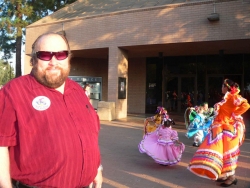Citizens express ire over arts mismanagement
by Gayle Early
“That theater has been referred to as the white elephant sitting in the middle of El Cajon. It ought to be the jewel of that city, the community place to pull people in together.”—Patricia Parlin
“I don’t have a lot of faith in them. I don’t think they’ll do the right thing.”—John Martes
December 17, 2009 (El Cajon)—Smack in the heart of El Cajon’s business promenade sits a soon-to-be darkened, empty theater. On Tuesday, arts lovers and concerned citizens showed up to the first community forum over the summary closure and renovation plans for the East County Performing Arts Center (ECPAC). After millions in local infrastructure improvements, the City is anxiously casting for ways to entice people to its downtown.
 The meeting was moderated by Deputy City Manager and Director of Public Works Rob Turner. Although Mayor Mark Lewis has repeatedly stated that his intent is to improve the theater, not close it long term, neither the Mayor nor any members of the City Council attended this first of two planned forums for public comment.
The meeting was moderated by Deputy City Manager and Director of Public Works Rob Turner. Although Mayor Mark Lewis has repeatedly stated that his intent is to improve the theater, not close it long term, neither the Mayor nor any members of the City Council attended this first of two planned forums for public comment.
Not five minutes into his presentation, Turner was grilled over the City’s true intentions for ECPAC. Most of the two dozen in attendance expressed grave concerns over the theater’s future and the City’s handling of it. They questioned why the theater had to remain dark for a year during initial renovation planning stages.
“We’re concerned about what you think you’re going to do with the theater,” said Grossmont Community Concert Association President (GCCA) Ron Shelby, who uses the facility for its concerts.
Turner said that by February, his staff will offer recommendations to the El Cajon City
Council about the proposed scope of renovations and an operating plan. They aim to find a balance between providing a cultural benefit to the City and economic benefits to downtown, with projected revenues and the cost of subsidies to keep ECPAC running.
Turner said the downtime during renovation will allow the City “to step back and take a look at how we really want to operate the theater.”
To that end the City has hired consultant Kurt Swanson, who has ten years’ consulting experience with private and community theaters and was project manager in the design of a successful theater. Swanson will crunch dollar scenarios to see what kind of community demographics and options East County affords. The level of building upgrade will be commensurate with the professional level of future shows.
 As an example, Swanson said it costs $20,000-50,000 per show for a headliner act. “You need to make sure you have the demographics to support the ticket sales,” although he delineated several ways a theater can generate income. That level of professional performance, in turns, dictates the quality of theatrical upgrades.
As an example, Swanson said it costs $20,000-50,000 per show for a headliner act. “You need to make sure you have the demographics to support the ticket sales,” although he delineated several ways a theater can generate income. That level of professional performance, in turns, dictates the quality of theatrical upgrades.
Patricia Parlin, who is active in the GCCA and community arts scholarship programs, expressed concern that the community would not be able to participate substantially in plans for the theater and that two brief meetings were not enough time for public input, by February. She conceded that it was a relief the City hired a qualified professional consultant to handle ECPAC’s issues.
Credibility Gap Between Arts Community and City Council
“There’s been no effective management [of ECPAC] for years,” Shelby said, referring to the City’s two recent contracts with Christian Community Theater (CCT) and its front management companyArtBeat’s failure to generate sufficient revenue while managing the facility.
John Martes, who made an unsuccessful bid for City Council last year, observed, “CCT didn’t pay any rent, violated their contract, and then we had to pay $200,000 to help bail them out, for their expenses.”
Peter Cuthbert, a longtime local planner, noted that when the City finally did an audit of CCT, it “found out the whole thing was a house of cards.” He suggested that, after renovation, the number one issue is to hire a very professional management group and audit it regularly, “so we know we’re getting our money’s worth as citizens.”
“I’m more concerned with stewardship of the City Council,” said Martes. “They make decisions on who’s going to run this. Their track record is very weak.”
Shelby pointed out that even “a bunch of amateurs,” like the GCCA, working independently of ArtBeat’s management team, have consistently managed to sell out six community concerts a year at ECPAC, which has over 1100 seats. The GCCA brings artists from all over the world, through theatrical agencies, at reasonable costs, he said.
Ray Lutz, founder of CitizensOversight.org, a watchdog group, and also former president of the GCCA, said the public is disenchanted because it has seen the review process go awry before. He said the City Council has typically done a “song and dance--like here. Everybody feels happy that they’ve said their two cents, then they go off, and then you get this deal where [the contracts are] given away to the friends of the City, like with CCT, Hamman Company, Priest [Construction].”
Turner responded, “Sir, I am not working with Hamman Construction. I’m working with [our consultant] and we’re going to make the best recommendations to City Council we can.”
Cuthbert suggested the Council institute a citizens’ advisory committee to participate in the entire renovation of theater-operation planning process, a suggestion Turner found helpful.
Parlin complained that she attended all the public meetings on the City’s five-year plan, and in not one of them did the City list or even discuss plans for ECPAC, even when prompted. She said in the City’s “Zone 1” downtown area planning document, “the theater isn’t even on the map; there’s just an empty space.” She was told ‘that was “open space” and it can be whatever we want it to be.’
“When you get that from City government, and then hear they want to make these improvements in a plan in two months? It doesn’t make a lot of sense,” Parlin stated.
Turner said that map is just for general zoning, and that all parties wanted the same thing for the theater, just as long as supporting it is commercially viable for the City.
Community Arts Center Larger Than Sum of Its Revenues
 Many agreed that running a community theater is not just about making revenues, but the heart and soul of a thriving community. “All fine arts need some kind of community support,” Parlin said. “We know that. We need to expand that venue [to bring in more income] for a whole variety of activities.”
Many agreed that running a community theater is not just about making revenues, but the heart and soul of a thriving community. “All fine arts need some kind of community support,” Parlin said. “We know that. We need to expand that venue [to bring in more income] for a whole variety of activities.”
Parlin asked pointedly if the City’s grant writer was looking into fine arts grants or applying for any stimulus grant money.
Swanson said it was better to rely on things that consistently generate money, such as ticket sales, rentals, concessions, advertising, and sponsors for high-end talent. “The more successful and active a building is, the better you do,” he said.
Gary Lewis, Executive Director of San Diego Musical Theater, said, “I’m not expecting ECPAC to generate money. Certainly businesses nearby will benefit. It’s not about making money, but supporting the community.”
The community also needs to pick up the slack where arts education leaves off, some observers noted.
Judy James was a teacher for thirty years and ushered at ECPAC for ten. With all the cuts to music and the arts in public schools, she felt the community itself needs help educate new generations to appreciate art.
“All it takes is one generation not being exposed to art,” she said. “If people aren’t educated to appreciate the theater, they’re not going to put out [money] for a ticket. They don’t appreciate it. And between you and me I’m not too sure the City Council appreciates the arts.”
James said, “I’ve seen [the theater] go up and down, I’ve gone to all the meetings when things needed to be improved. In all that time I have never felt that the City Council supported the theater.” She said plenty of people in the community were willing to help support and sponsor ECPAC, but the City did not match this motivation with the same level of commitment.
James also expressed concern that shutting down ECPAC for two years will cause the community venue to lose too much momentum. “Going to the theater is a habit. If you break a habit for two years, you have to reestablish the habit. It’s going to take a long time to bring that theater back up where all the sudden everybody rushes in.”
Monica Zeck, Public Information Officer for the City, said scheduling and personal issues prevented Council members from attending this meeting, but they plan to be at the next one in January.
“Some of the Council people would be really offended that you said they weren’t interested in the arts,” Zeck said. “Throwing accusations and comments and assumptions is offensive. We’re here to find out what you want to see happen. We’ve got a lot of new people involved. What positive things do you want to happen to make this facility something we can be proud of.
“We want to see ideas from people who want to move forward and see great things happen for our city. People will come for the arts. I have a lot of people say, ‘We plan to come back as soon as you reopen it.’ A lot of schools, new people moving into the community—they love the arts.”
GCCA President Shelby also pointed out that “plenty of folks right now want to come into town to see a star, not drive twenty miles in the dark [elsewhere], especially senior citizens.”
Downsizing Rumors and Renovation Plans
As to rumors of downsizing the theater, Turner said the City hopes to actually increase seating to 1200 seats. Swanson said, “There’s no way you could make the theater smaller and keep it commercially viable.”
Turner said they will preserve the fantastic acoustic qualities of the venue, although improvements to the sound system are in order. For a structure built in the seventies, it could use significant revamping, starting with a leaky roof and ADA requirements for handicap access. There are HVAC and plumbing issues. To open itself up to bigger theater or ballet productions, the stage needs to be expanded to accommodate scenery and lifts, with better rigging and lighting.
Other proposed improvements include adding more restrooms, increasing the size of the facility’s small dressing rooms, and overhauling the loading dock. Mayor Mark Lewis has on his wish list adding a front entrance to Main Street, hoping to lure pedestrian traffic to downtown establishments.
Turner estimated that renovation plans would cost the City at least a million dollars, probably more.
Turner hopes to hire an architect in March or April, have a design in hand and advertise for bids by September, award the construction contract by December, and take six to eight months to renovate. The facility could be ready as early as May 2011, coinciding with completion of the Public Safety Center, or by Labor Day at the end of summer.
Theater Closure
The City created a brouhaha over summarily closing ECPAC, citing the local construction in the Civic Center block and temporary lack of parking, not to mention the economic downturn as an opportunity to make renovations and handle deferred maintenance issues over the next two years. Arts organizations with booked events, such as the GCCA balked, suddenly abandoned without a venue. After the outcry, The City decided that the theater will continue to operate for the GCCA and other booked events, at least until May 2010.
Martes said if the City truly cared about parking for Arts events, it wouldn’t have sold nearby land to Priest Construction. “They sold that land for a song. The property was worth $20 million and they sold it for $2½ million….That property could have been used for parking.”
Lutz opined that if the City truly cared about keeping the theater running, it would have planned better for parking options during the Public Safety Center construction.
Regarding “closing the theater out of the blue,” Lutz said, “You can’t grow the culture of the City with quick mind-changes. Changes that could affect the willingness of local patrons to donate. We don’t know what the City’s going to do because they haven’t shown they have the vision for what it can be.”
A heated exchange followed between Lutz and Gary Lewis, a member of the former blue ribbon commission that has endured criticism for its perceived control over hiring the management firm, ArtBeat. Lewis said the commission merely recommended a subsidy to hire a management team, not any particular agency.
Swanson said the level of frustration in the room “is typical in these kinds of communities where the theater is not doing well.” Responsibility for that failure, some felt, lies directly in the hands of City stewardship.
Turner said he would like the City to move forward, rather than rehash past mistakes. “If you have thoughts about how to put together a business and renovation plan that works, I’d really like to hear them.”
The agenda is the same for the next meeting: soliciting public comment about proposed renovations. Thursday, January 21, 2010, 7:00–8:00 PM at Ronald Reagan Community Center, 195 East Douglas Ave., (619) 441-1673.
The City requests that you RSVP to the Recreation Department at (619) 441-1754. No more than three people from any one organization are requested to attend, as seating is limited.















Recent comments